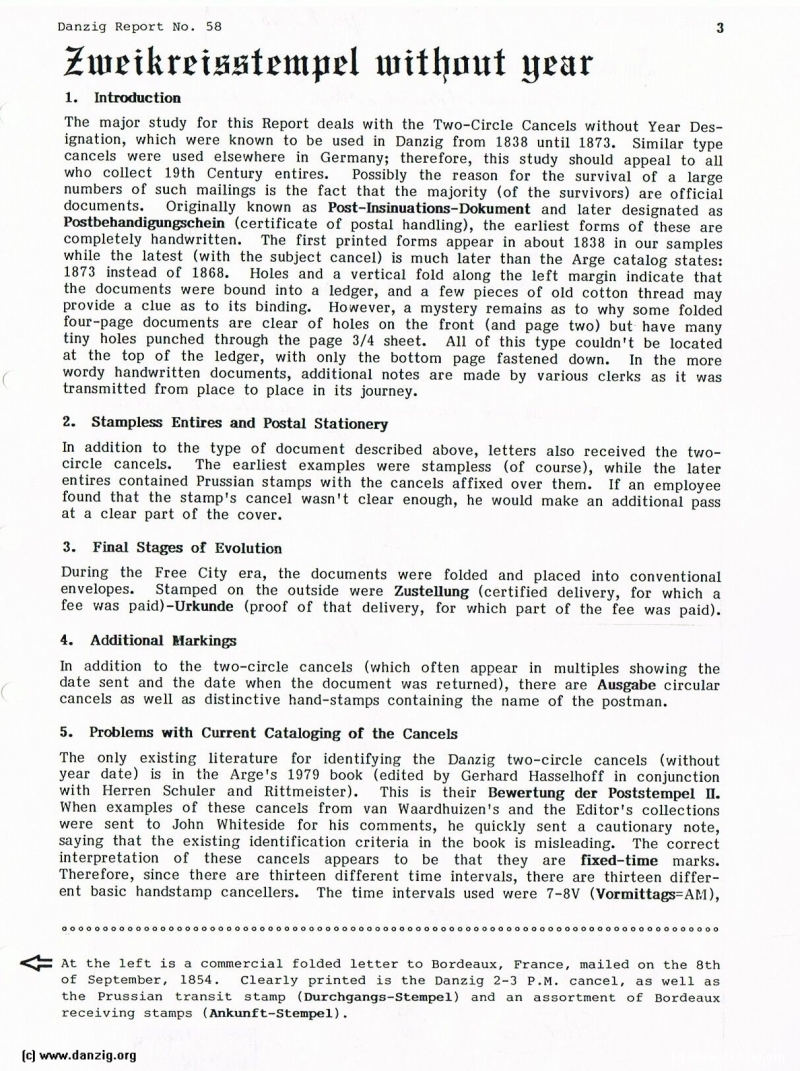
Zweikreisstempel without year
1. Introduction
The major study for this Report deals with the Two—Circle Cancels without Year Des gnation, which were known to be used in Danzig from 1838 until 1873. Similar type cancels were used elsewhere in Germany; therefore, this study should appeal to all who collect 19th Century entires. Possibly the reason for the survival of a large numbers of such mailings is the fact that the majority (of the survivors) are official documents. Originally known as Post—Insinuations—Dokument and later designated as Postbehandigungschein (certificate of postal handling), the earliest forms of these are completely handwritten. The first printed forms appear in about 1838 in our samples while the latest (with the subject cancel) is much later than the Arge catalog states: 1873 instead of 1868. Holes and a vertical fold along the left margin indicate that the documents were bound into a ledger, and a few pieces of old cotton thread may provide a clue as to its binding. However, a mystery remains as to why some folded four-page documents are clear of holes on the front (and page two) but have many tiny holes punched through the page 3/4 sheet. All of this type couldn’t be located at the top of the ledger, with only the bottom page fastened down. In the more wordy handwritten documents, additional notes are made by various clerks as it was transmitted from place to place in its journey.
2. Stampless Entires and Postal Stationery
In addition to the type of document described above, letters also received the two- circle cancels. The earliest examples were stampless (of course), while the later entires contained Prussian stamps with the cancels affixed over them. If an employee found that the stamp’s cancel wasn’t clear enough, he would make an additional pass at a clear part of the cover.
3. Final Stages of Evolution
During the Free City era, the documents were folded and placed into conventional envelopes. Stamped on the outside were Zustellung (certified delivery, for which a fee was paid)—Urkunde (proof of that delivery, for which part of the fee was paid).
4. Additional Markings
In addition to the two—circle cancels (which often appear in multiples showing the date sent and the date when the document was returned), there are Ausgabe circular cancels as well as distinctive hand-stamps containing the name of the postman.
5. Problems with Current Cataloging of the Cancels
The only existing literature for identifying the Danzig two—circle cancels (without year date) is in the Arge’s 1979 book (edited by Gerhard Hasselhoff in conjunction with Herren Schuler and Rittmeister). This is their I3ewertung der Poststempel II. When examples of these cancels from van Waardhuizen’s and the Editor’s collections were sent to John Whiteside for his comments, he quickly sent a cautionary note, saying that the existing identification criteria in the book is misleading. The correct interpretation of these cancels appears to be that they are fixed—time marks. Therefore, since there are thirteen different time intervals, there are thirteen differe nt basic handstamp cancellers. The time intervals used were 7—8V (Vormittags=AM),
At the left is a commercial folded letter to Bordeaux, France, mailed on the 8th of September, 1854. Clearly printed is the Danzig 2-3 P.M. cancel, as well as the Pru5sian transit stamp (Durchgangs-Stempel) and an assortment of Bordeaux receiving stamps (Ankunft-Stempel).
Danzig Report Nr. 58 - January - February - March - 1988, Page 4.
Hits: 4308
Added: 24/06/2015
Copyright: 2025 Danzig.org

